Saccade-based Display
( 日本語はこちら )
Full-scale
Saccade-based Display was presented in SIGGRAPH2007
Hideyuki Ando, Junji Watanabe,
Tomohiro Amemiya, Taro Maeda
"Full- Scale Saccade-Based Display:
Public/Private Image Presentation Based on Gaze-Contingent Visual Illusion"
SIGGRAPH 2007 Emerging Technologies proceedings. PDFfile
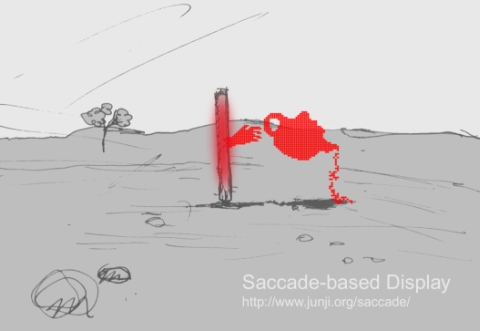
| The display of 2D images is fundamental to nearly all forms of visual presentation, and pursuing display methods based on insight of human perception may reveal many new possibilities. Information display should be thought of as a conjunction of both the human and the device, and there are still many resources available on the human side. Here, we propose a 2D information display system, which uses perceptional features during eye movements. |
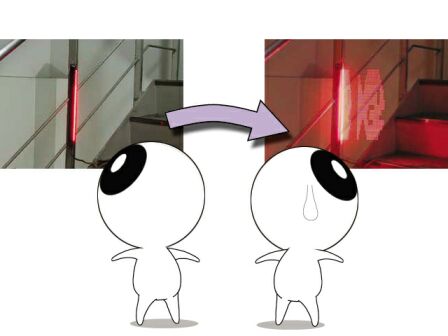
Picture by Jun KURUMISAWA
| The shifts of the gaze are usually achieved by rapid eye movements called saccades. As a perceptual feature during the saccade, it is known that when a light source flickers during the time of a saccade in a dark environment, a dotted array can be perceived due to retinal afterimages. |

| If light sources are fixed on a vertical line, instead of a point, and the flashing pattern is changed quickly during a horizontal saccade, 2D images can be perceived. The flashing pattern is expanded to a spatial pattern by the eye movement as in following figure. During the eye movement, the vertical light array travels on the retina, while it changes the flashing pattern. Then, the different vertical images at different retinal positions are integrated to a 2D image. |
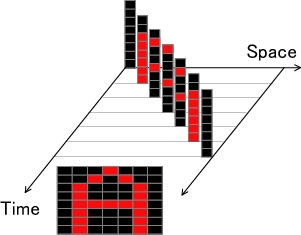
|
When a flickering light array moves at a fast enough speed, we can perceive 2D images through retinal afterimages
as in following figure left (ISM Inc. Fantazein). Conversely, Saccade-based
Display make afterimage by viewer's eye movement as in the figure right. The
painted image on the retina is relatively the same. It thus enable us to present 2D images
without any screen only with 1 dimensional light sources, and to show images even in midair in dim environment, since the image is generated due to retinal
afterimages.
In order to display information, there is only one column of
lights on the device side, but when well coordinated with eye movement, its display capability is multiplied.
Please see the VIDEOs! |
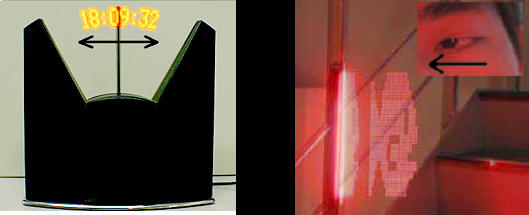
ISM Inc. Fantazein
Saccade-based Display
| Our purpose is to construct a unique display by using the saccade eye movement. We can display information in a space outside of the device itself and put images on our surrounding environment. For example, we will set our display at various places in a hall, a pillar of doors, between the booths, stairs and aisles. We can attach our display in any place dark enough to use it. This application is leading to Augmented Reality systems. This display can be a visual effects for art stages. So far we need a physical line of LEDs to show images. For the future work, by simply projecting a flickering line of light we would make a virtual Saccade-based Display able to present information anywhere. |
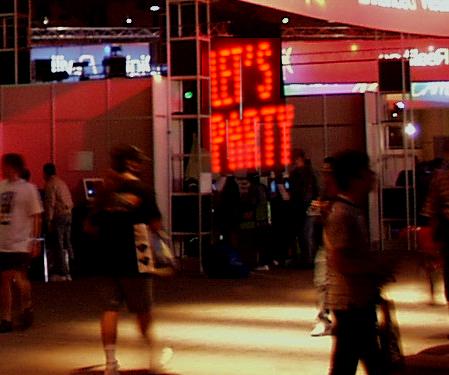
|
The display capability of the saccade-based display was limited to
simple characters like in fig. above. However, recent technological progress of FPGA (Field Programmable Gate Array) enables us to control the time unit within less than 10 us. Consequently, using an optimally designed FPGA circuit, we have succeeded in full-scale color image presentation with large LED array as shown in fig. below. Even life-size photographic images such as humans and landscapes can be displayed. |
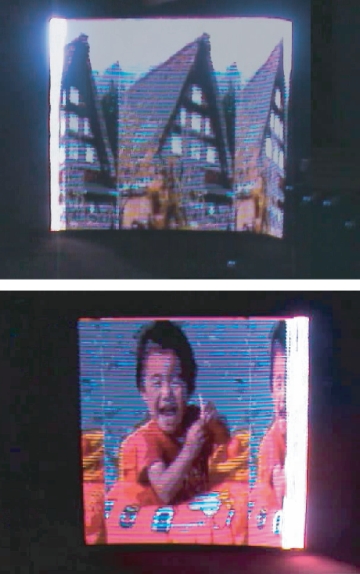
| This display also has deficits. This display functions mainly in dark or dim places, and 2D images are perceived only when the timing of the saccade coincides with the flash timing. If the timing is off, only 1 dimensional light will be perceived, instead of 2D image. Of course, our eyes are moving naturally, but the timing is arbitrary. We can induce eye movements by light stimulus and other inducers. For example, when one light point turns on then, it turn off and another point turn on, our eye movement toward it is induced. Or we set the display at the places where eye movements occur naturally such as dance floor, rotating stairs. Additionally we can present 2D images reliably using the EOG (Electro Ocular Graph)-based real-time saccade detecting system. |
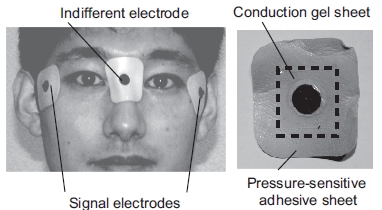
|
Consider the situation in
the fig. below, where persons A and B are observing the display and a saccade detection device
continuously detects the wearer's saccade. At time t1 in fig. (a), when person A's saccade is detected, a 2D image is presented only
to person A by flickering the LED array. On the other hand, person B doesn't move his eyes at this time, so he can see only a single
array of LEDs. In contrast, at time t2 in fig. (b), person B's saccade is detected and only person B can see a different 2D image.
The system consisting of a wearable sensor (saccade detector) and a space-saving ubiquitous display (saccade-based display) would
make it possible to selectively present confidential information to the viewers. |
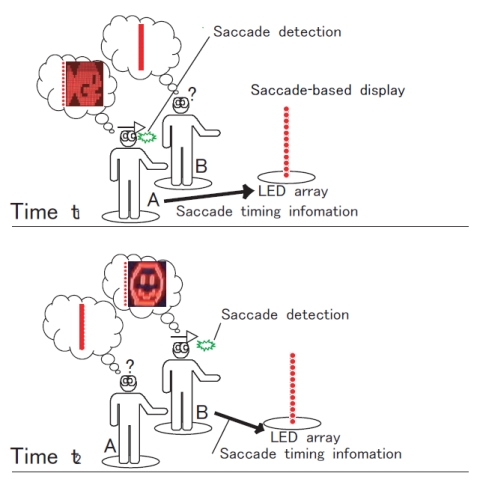
References
|
Junji Watanabe,
Hideyuki Ando, Taro Maeda, Susumu Tachi "Gaze-contingent Visual Presentation based on Remote Saccade Detection" Presence : Teleoperators and Virtual Environments, Vol.16, No.2, pp. 224-234, 2007. PDFfile Noritake Atsushi, Junji Watanabe, Hideyuki Ando, Masahiko Terao, Akihiro Yagi "Spatial dependency of saccade-induced image" Psychologia, Vol. 48, No. 2, pp. 146-153, 2005. PDFfile Junji Watanabe, Taro Maeda, Susumu Tachi "Time Course of Localization for a Repeatedly Flashing Stimulus Presented at Perisaccadic Timing" Systems and Computers in Japan, Vol. 36, No. 9, pp.77-86, 2005. PDFfile Junji Watanabe, Atsushi Noritake, Taro Maeda, Susumu Tachi, Shin'ya Nishida "Perisaccadic Perception of Continuous Flickers" Vision Research, Vol. 45, No. 4, pp. 413-430, 2005. PDFfile Reiko Aruga, Hideo Saito, Hideyuki Ando,
Junji Watanabe Bill Bell, Theodore E. Parks and Robert B. Post |
Links
| Bill Bell's Website (a pioneer artist of this saccade-phenomenon) "Subliminary Artworks" |
Acknowledgement
AVIX
inc. (LED device presented in SIGGRAPH2007)
Tachi laboratory in Tokyo
University
contact Junji Watanabe: junji.watanabe.sp(at)hco.ntt.co.jp
copyright (c) Junji Watanabe 2018